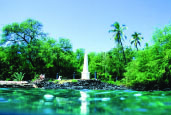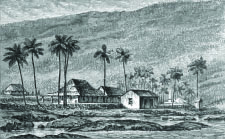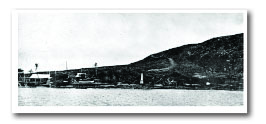
Then & Now: Ka‘awaloa
By Ann C. Peterson

To reach the remote site of the Captain Cook Monument, you have to kayak, hike, or ride on horseback to this narrow stretch of land between the base of Pali-kapu-o-Keoua and Kealakekua Bay. This land’s Hawaiian name is Ka`awaloa (lit. the long, standing place), and although the area’s rich legacy is often relegated to the tragic death of the Captain James Cook in 1779, few people remember there was once an important and thriving village there.
After Cook’s death, Kamehameha I often visited Ka`awaloa, and from this site launched a key battle in his attempt to unite the island at Mokuohai in 1782. The grim site of this battle is just south of Kahualoa Road in Napo`opo`o Village.
Kamehameha was again at the bay to welcome Captain Vancouver and receive his present of the first cattle in Hawai‘i during his 1793-94 voyages. The arrival of the longhorn cattle at Ka`awaloa launched Hawaii’s paniolo culture. Vancouver also brought to Ka`awaloa the first orange trees to the islands in 1793.
Around 1820, Naihe, son of Keaweaheulu, Ka`awaloa’s chief, married high chiefess Kapiolani of Hilo and brought her to live at Ka`awaloa. Their residence reflected their love of beauty and nature – with thatched cottages on a raised platform, surrounded by walls three feet thick, and a painted gate where Kapiolani warmly greeted her guests.
In 1825, author Rufus Anderson described the inside of their spacious home as, “Handsomely arranged, well furnished, and neatly kept, with a sitting room, in which a nobleman, in such a climate, might be happy to lounge; and bedrooms adjoining, where, in addition to couches which the most fastidious would unhesitatingly occupy, are found mirrors and toilet tables fitted for the dressing-room of a modern belle.”
Kapiolani, an early convert to Christianity, invited the church to open a missionary at Ka`awaloa and prepared a large, thatched parsonage with several glass windows within 20 yards of Cook’s monument.
In 1829, Queen Ka`ahumanu deconstructed the Hale a Keawe at Pu`uhonua o Honaunau and entombed the remains of 24 chiefs in the pali above Ka`awaloa. She visited again in 1831, when Naihe died. Kapiolani lived 10 more years – spending the last few just above Ka`awaloa at the 1500-foot elevation.

King Kalakaua’s niece, Princess Ka`iulani, known until her untimely death as the “Hope of Hawai`i” visited the royalty’s vacation home at Ka`awaloa in 1885 with her mother, Miriam Likelike. She happily traded her heavy gowns for a holoku and her tortoise-shell carriage for a donkey. Away from the strict protocol of O`ahu’s polite society, she played and swam in the queen’s bath near the base of the pali, and celebrated her tenth birthday completely happy for a time in the sleepy little village.
Author and world traveler Jack London enjoyed a high luau at Ka`awaloa in the company of Mr. Henry Leslie in 1907. Leslie was a resident of Ka`awaloa at the time a portion of the land was ceded to the British for the monument to their fallen hero, Captain Cook. He served as the first of three generations of Leslies who have cared for the monument to this day.

Today, Ka`awaloa is unique; the site of this little piece of non-embassy British land within the United States. All visitors are requested to honor the area, as it holds the piko (umbilical cords) of many Hawaiians who once thrived upon its shores. The bay’s designation as a marine reserve, which restricts fishing, makes it a place favored by swimmers and snorkelers. ❖


